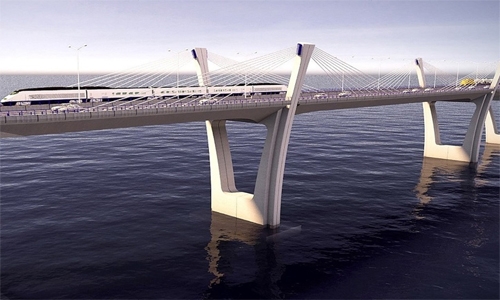King Hamad Causeway project in stage of developing strategic implementation plan
TDT | Manama
The Daily Tribune – www.newsofbahrain.com
The King Hamad Causeway project is in the stage of developing a strategic implementation plan and preparing financial models. This was discussed during yesterday’s Ministerial Committee for Development and Infrastructure Projects weekly meeting held remotely and chaired by Deputy Prime Minister Shaikh Khalid bin Abdulla Al Khalifa.
It is one of the strategic projects in the land transportation sector as part of Bahrain’s Economic Vision 2030 initiatives under the wise leadership of His Majesty King Hamad bin Isa Al Khalifa and His Royal Highness Prince Salman bin Hamad Al Khalifa, the Crown Prince and Prime Minister.
The Deputy Prime Minister directed the Urban Planning and Development Authority, in coordination with the Ministry of Transportation and Communications, to quickly complete the reservation of the final route of the King Hamad Causeway, which is linked to the railways of the Gulf Cooperation Council (GCC) countries.
He also ordered the Authority to take the necessary measures to acquire and compensate the affected lands at King Hamad International Station, and study the best ways to compensate for the lands affected by the railways and the path designated by the bridge for vehicles between the Jasra area and Action Island.
The King Hamad Causeway is a futuristic bridge parallel to the King Fahd Causeway and complementary to the Gulf railway network project. Work on the project is being carried out in coordination and cooperation between the Ministry of Transportation and Communications, and its counterpart in the Kingdom of Saudi Arabia, and the King Fahd Causeway Public Corporation.
The project, which will link Bahrain with Saudi Arabia, through the passenger terminal in Dammam, to King Hamad International Station in the Ramli area, will be implemented in partnership with the private sector.
The initial draft of the implementation strategy should be submitted to the competent authorities in both countries, and then present the same strategy to the Higher Supervisory Committee to obtain the necessary approvals, in preparation for the transition of the assigned consultant to the next stages.
According to the approved feasibility study, the King Hamad Causeway, which will improve and raise the efficiency of transport operations between the two brotherly countries, consists of four lanes in each direction with a length of 25 km, and a two-track railway with a length of 57 kilometres, including seven kilometres within Bahrain.
The study also showed that the implementation of the project, in partnership with the private sector, will ensure the provision of the necessary financial resources to design, build, finance, operate and maintain the vehicle track and the railway track. The latest developments on the Gulf Train Project, which will link the internal networks of the six Gulf countries with major railways with a length of 1860 km, was also discussed.
Transportation and Telecommunications Minister Eng. Kamal bin Ahmed Mohammed briefed the Ministerial Committee on the steps that have been completed in coordination with the General Secretariat of the GCC in preparing the project. He also outlined the studies on the expectations of the volume and movement of passengers and goods, whose outputs will result in the preparation of the operational plan.
It is scheduled to be on the agenda of the next meeting of the Supreme Council of the Cooperation Council, and the proposal to establish the Gulf Railways Authority.
The Bahrain Metro project was also discussed in the meeting. The consultancy services for the Bahrain Metro project are among the projects included in the government’s program (2019-2022) and funded from the state’s general budget at a value of BD1.7 million.
This project is aimed at providing alternative and modern systems and reducing traffic congestion in the streets of Bahrain, with a planned lane of 109 kilometres in length, and with a capacity of 43,000 passengers per hour.
Related Posts

